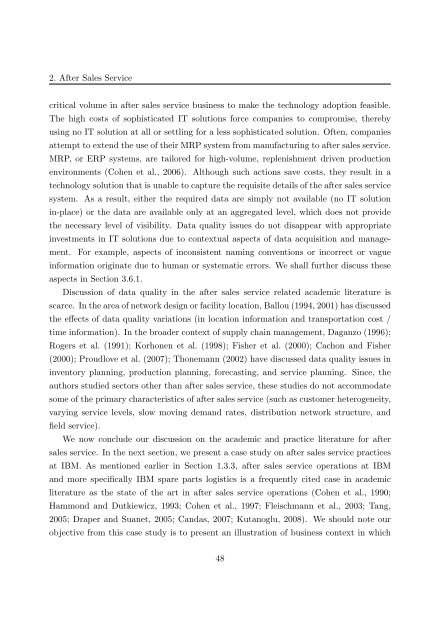Customer Information Driven After Sales Service ... - RePub
Customer Information Driven After Sales Service ... - RePub
Customer Information Driven After Sales Service ... - RePub
You also want an ePaper? Increase the reach of your titles
YUMPU automatically turns print PDFs into web optimized ePapers that Google loves.
2. <strong>After</strong> <strong>Sales</strong> <strong>Service</strong><br />
critical volume in after sales service business to make the technology adoption feasible.<br />
The high costs of sophisticated IT solutions force companies to compromise, thereby<br />
using no IT solution at all or settling for a less sophisticated solution. Often, companies<br />
attempt to extend the use of their MRP system from manufacturing to after sales service.<br />
MRP, or ERP systems, are tailored for high-volume, replenishment driven production<br />
environments (Cohen et al., 2006). Although such actions save costs, they result in a<br />
technology solution that is unable to capture the requisite details of the after sales service<br />
system. As a result, either the required data are simply not available (no IT solution<br />
in-place) or the data are available only at an aggregated level, which does not provide<br />
the necessary level of visibility. Data quality issues do not disappear with appropriate<br />
investments in IT solutions due to contextual aspects of data acquisition and management.<br />
For example, aspects of inconsistent naming conventions or incorrect or vague<br />
information originate due to human or systematic errors. We shall further discuss these<br />
aspects in Section 3.6.1.<br />
Discussion of data quality in the after sales service related academic literature is<br />
scarce. In the area of network design or facility location, Ballou (1994, 2001) has discussed<br />
the effects of data quality variations (in location information and transportation cost /<br />
time information). In the broader context of supply chain management, Daganzo (1996);<br />
Rogers et al. (1991); Korhonen et al. (1998); Fisher et al. (2000); Cachon and Fisher<br />
(2000); Proudlove et al. (2007); Thonemann (2002) have discussed data quality issues in<br />
inventory planning, production planning, forecasting, and service planning. Since, the<br />
authors studied sectors other than after sales service, these studies do not accommodate<br />
some of the primary characteristics of after sales service (such as customer heterogeneity,<br />
varying service levels, slow moving demand rates, distribution network structure, and<br />
field service).<br />
We now conclude our discussion on the academic and practice literature for after<br />
sales service. In the next section, we present a case study on after sales service practices<br />
at IBM. As mentioned earlier in Section 1.3.3, after sales service operations at IBM<br />
and more specifically IBM spare parts logistics is a frequently cited case in academic<br />
literature as the state of the art in after sales service operations (Cohen et al., 1990;<br />
Hammond and Dutkiewicz, 1993; Cohen et al., 1997; Fleischmann et al., 2003; Tang,<br />
2005; Draper and Suanet, 2005; Candas, 2007; Kutanoglu, 2008). We should note our<br />
objective from this case study is to present an illustration of business context in which<br />
48

















